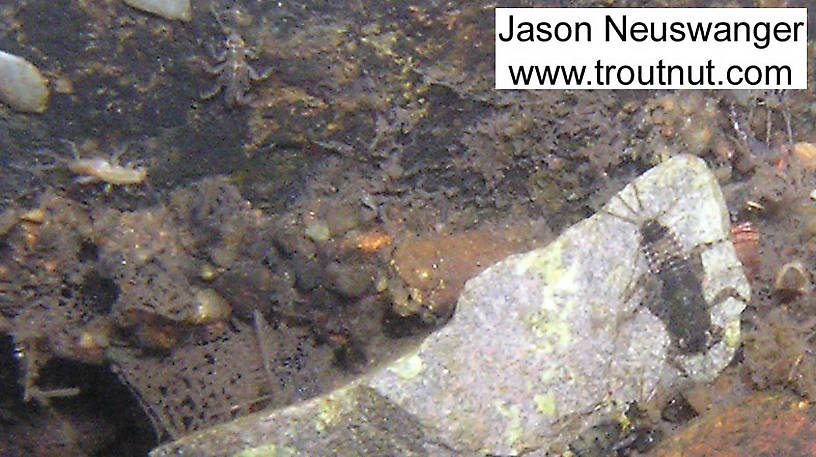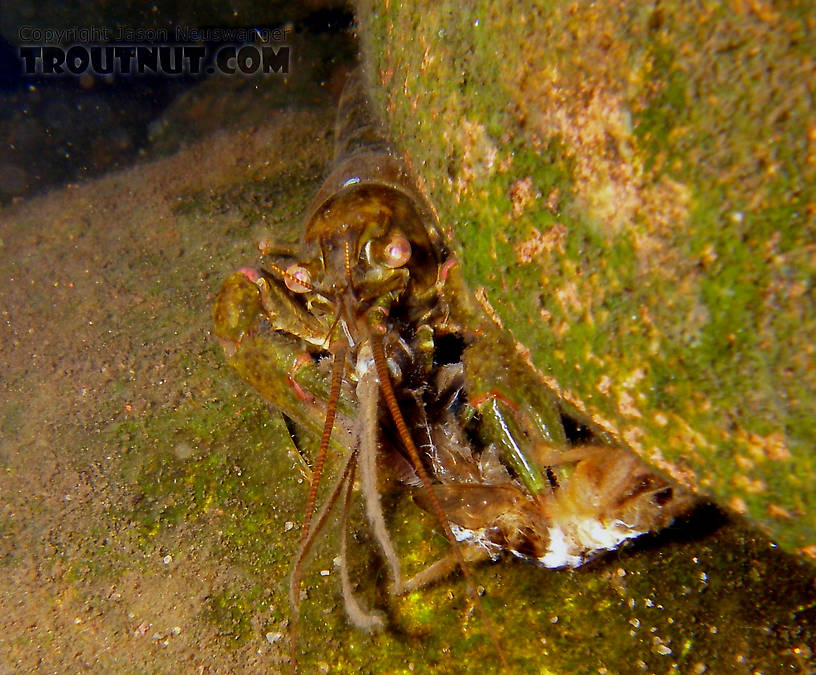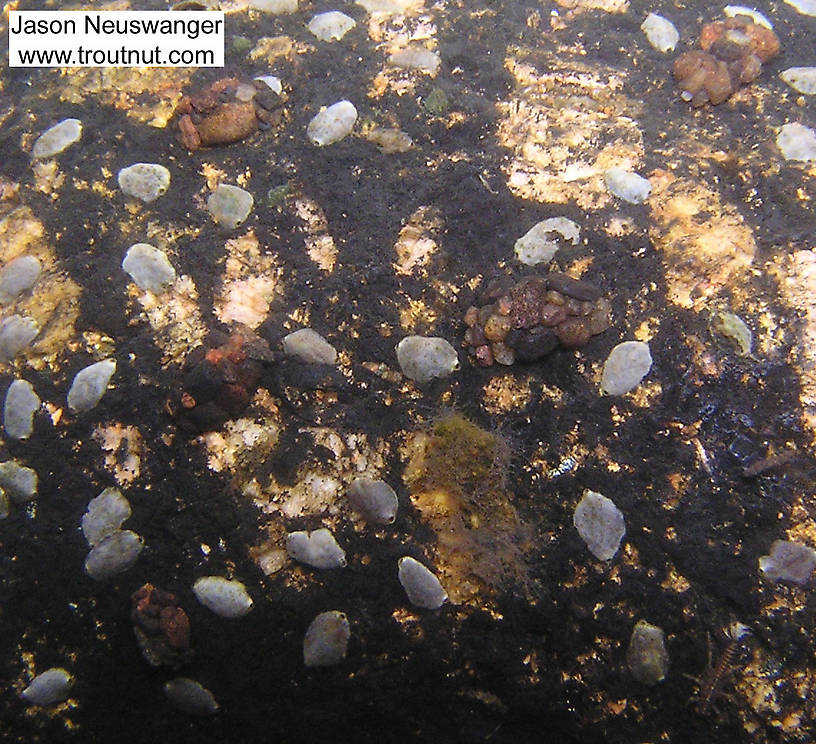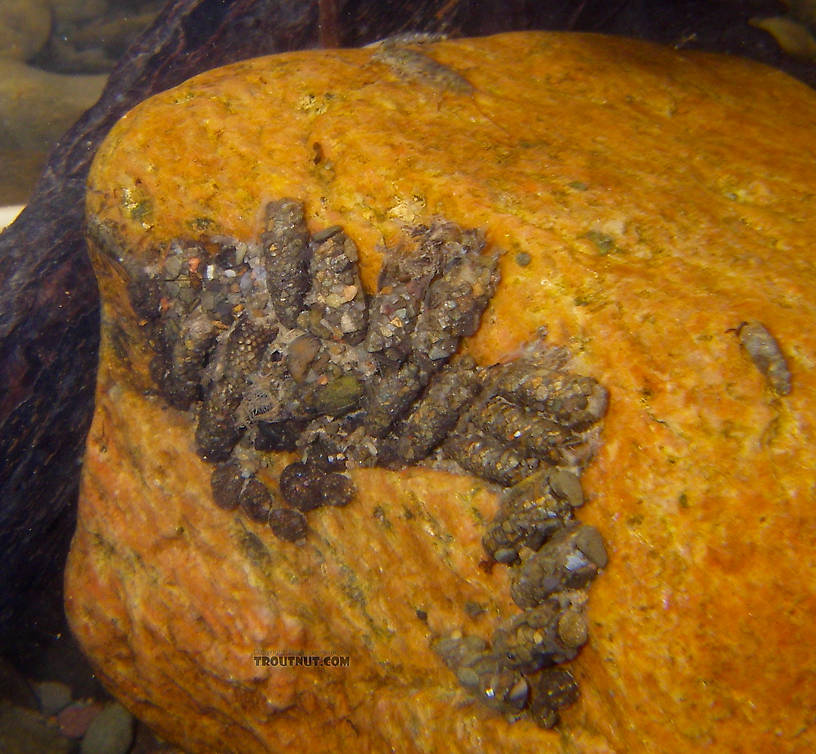Blog & Latest Updates
Fly Fishing Articles
Insects by Common Name


Arthropod Class Insecta (Insects)
Taxonomic Navigation -?-
1 order isn't included.
Common Name
| Match | Common Name |
| Insects |
This is page 3 of underwater photos of Insecta. Visit the main Insecta page for:
- The behavior and habitat of Insecta.
- Studio pictures of 1229 Insecta specimens.
114 Underwater Pictures of Insects:

Hundreds of cased caddis larvae cling to sparse weed growth in the sand under heavy current.
In this picture: Insect Order Trichoptera (Caddisflies).
In this picture: Insect Order Trichoptera (Caddisflies).
StateWisconsin
LocationEighteenmile Creek
Date TakenApr 14, 2004
Date AddedJan 25, 2006
AuthorTroutnut
CameraOlympus C740UZ

Some large Ephemerella mayfly nymphs cling to a log. In the background, hundreds of Simuliidae black fly larvae swing in large clusters in the current.
In this picture: Mayfly Species Ephemerella subvaria (Hendrickson), True Fly Family Simuliidae (Black Flies), and Mayfly Species Ephemerella invaria (Sulphur Dun).
In this picture: Mayfly Species Ephemerella subvaria (Hendrickson), True Fly Family Simuliidae (Black Flies), and Mayfly Species Ephemerella invaria (Sulphur Dun).
StateWisconsin
LocationNamekagon River
Date TakenMar 20, 2004
Date AddedJan 25, 2006
AuthorTroutnut
CameraOlympus C740UZ

Three big Ephemerella subvaria mayfly nymphs share a rock with some cased caddis larvae.
In this picture: Mayfly Species Ephemerella subvaria (Hendrickson) and Saddle-case Maker Genus Glossosoma (Little Brown Short-horned Sedges).
In this picture: Mayfly Species Ephemerella subvaria (Hendrickson) and Saddle-case Maker Genus Glossosoma (Little Brown Short-horned Sedges).
StateWisconsin
LocationNamekagon River
Date TakenMar 20, 2004
Date AddedJan 25, 2006
AuthorTroutnut
CameraOlympus C740UZ

An Ephemerella subvaria nymph clings to a white rock in the foreground, and there are other nymphs in the background.
In this picture: Mayfly Species Ephemerella subvaria (Hendrickson) and Insect Order Trichoptera (Caddisflies).
In this picture: Mayfly Species Ephemerella subvaria (Hendrickson) and Insect Order Trichoptera (Caddisflies).
StateWisconsin
LocationNamekagon River
Date TakenMar 20, 2004
Date AddedJan 25, 2006
AuthorTroutnut
CameraOlympus C740UZ

A crayfish chews on a Hexagenia limbata nymph shortly after a small Hex emergence. I didn't catch any fish, but playing around with my flashlight and camera in the rocks proved productive.
In this picture: Arthropod Order Decapoda (Crayfish) and Mayfly Species Hexagenia limbata (Hex).
In this picture: Arthropod Order Decapoda (Crayfish) and Mayfly Species Hexagenia limbata (Hex).
StateWisconsin
LocationNamekagon River
Date TakenJun 14, 2006
Date AddedJun 30, 2006
AuthorTroutnut
CameraPENTAX Optio WPi

This Ephemerella subvaria (Hendrickson) nymph picture is one of my favorites.
In this picture: Mayfly Species Ephemerella subvaria (Hendrickson).
In this picture: Mayfly Species Ephemerella subvaria (Hendrickson).
StateWisconsin
LocationNamekagon River
Date TakenMar 24, 2004
Date AddedJan 25, 2006
AuthorTroutnut
CameraOlympus C740UZ

There's a stonefly nymph in the bottom right corner of this picture, but what's really interesting is those white blotches. They're pretty common in my Wisconsin home river river, stuck flat onto the rocks--lots of rocks have a speckled look as a result. They are microcaddis cases, made by larvae of the caddisfly family Hydroptilidae. These are made by larvae of the subfamily Leucotrichiinae, most likely the genus Leucotrichia. They spin little flat oval cases of silk tight and immobile against the rocks.
In this picture: Caddisfly Species Leucotrichia pictipes (Ring Horn Microcaddis).
In this picture: Caddisfly Species Leucotrichia pictipes (Ring Horn Microcaddis).
StateWisconsin
LocationNamekagon River
Date TakenMar 20, 2004
Date AddedJan 25, 2006
AuthorTroutnut
CameraOlympus C740UZ

StateWisconsin
LocationNamekagon River
Date TakenMar 24, 2004
Date AddedJan 25, 2006
AuthorTroutnut
CameraOlympus C740UZ


A variety of cased caddisfly larvae, probably mostly Neophylax, have clustered along the backside of a rock in fast water. There seem to be some Helicopsychidae larvae clustered along the bottom, and a few other taxa are mixed in. It's interesting that several larvae have especially large stones placed over the front openings of their cases, perhaps to block the case off for pupation.
It does seem to be the wrong time of year for Neophylax to be pupating, but that was the ID given for one of these which I collected and photographed up close.
In this picture: Caddisfly Genus Neophylax (Autumn Mottled Sedges) and Caddisfly Genus Helicopsyche (Speckled Peters).
It does seem to be the wrong time of year for Neophylax to be pupating, but that was the ID given for one of these which I collected and photographed up close.
In this picture: Caddisfly Genus Neophylax (Autumn Mottled Sedges) and Caddisfly Genus Helicopsyche (Speckled Peters).
StateNew York
LocationCayuta Creek
Date TakenApr 14, 2007
Date AddedMay 3, 2007
AuthorTroutnut
CameraPENTAX Optio WPi
Top 10 Fly Hatches
Top Gift Shop Designs
Eat mayflies.
Top Insect Specimens
Miscellaneous Sites
Troutnut.com is copyright © 2004-2024 Jason
Neuswanger (email Jason). See my FAQ for information about use of my images.
 privacy policy
privacy policy
